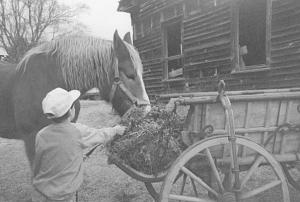2004 - Volume #28, Issue #2, Page #24
[ Sample Stories From This Issue | List of All Stories In This Issue | Print this story
| Read this issue]
Farmer Makes Friend Out Of Kudzu
 |
"We love it," says Henry Edwards. "It's a wonderful plant, but like anything else, only in its place."
The viney weed can grow as much as 1 ft. per day during the hot, humid months of summer and it thrives to such a degree in moist areas that it blankets anything and everything, including abandoned vehicles, buildings, and even power poles and trees. It can eventually kill trees by shading them.
Eighty-year-old Henry and his wife, Edith, 77, of Rutherfordton, North Carolina harvest kudzu on their 330-acre farm and use it for a variety of purposes.
Henry remembered from when he was a small child, his grandfather had great success feeding kudzu to cows.
So when he and Edith began dairy farming in 1962, they had a feed analysis done on kudzu at North Carolina State University. They learned that the deep-rooted vine with large, abundant leaves actually contained 21 percent protein and 35 percent fiber, making it just as good as alfalfa, but much cheaper to grow.
The Edwards say they can make more money from an acre of kudzu than they can from an acre of corn or an acre of hay.
"You can get about five tons per acre of kudzu silage compared to 1 1/2 tons per acre of hay," he says.
Edwards says cattle really like it. "You can't keep a fence between cattle and kudzu and it won't cause bloat like alfalfa," he points out. It's organic - you don't need to fertilize it and you don't need to spray it.
"Once planted, it lasts a lifetime. We've got some on this farm that's been here 70 years," he says. "When you go to bale it, you want to mow it close to the ground, and pick it up with the baler header in the transport position, so it doesn't catch on the uncut vines on the ground. You can mow it with a sickle mower, mower-conditioner or disc mower."
To increase yields, he plants rye, oats, barley or wheat into it in the fall.
The Edwards used the plant instead of corn silage for their dairy herd in the 60's and 70's, and were rewarded with the county's highest per cow annual average milk production. Henry says his dairy cows were eating 125 lbs. of kudzu silage per day.
The Edwards also fed kudzu to their horses, sheep, goats, hogs and chickens.
They didn't stop there, however. Edith decided to take the plant into her kitchen, cooking up a variety of innovative products with it. She makes a red jelly and pancake syrup from the sweet-smelling flowers. The taste has been compared to apples, pears or grapes. Edith also makes a type of kudzu relish with the blossom and a delicious quiche.
"I also make tasty snack fries by frying the leaves in a cold tempura batter. We've made a starch from the roots that is useful in food preparation and for medicinal purposes," she says.
The Edwards have sold root stock to such places as Bolivia, Puerto Rico, and even to Canada for indoor use. The Edwards put on kudzu education programs at local schools and they sell kudzu products and books on the plant.
Contact: FARM SHOW Followup, Henry and Edith Edwards, 722 Duncan Rd., Rutherfordton, N.C. 28139 (ph 828 245-9752; email: kudzukid@rfci.net).

Click here to download page story appeared in.

Click here to read entire issue
To read the rest of this story, download this issue below or click here to register with your account number.




